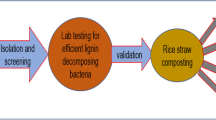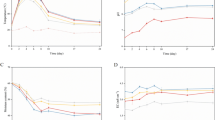Abstract
In the present work, the influence of feedstock composition (high and low lignin percentage) and addition of lignocellulose degrading bacterial isolates on final compost quality has been studied. The evaluation is based on respiration activity, temperature, nitrate and humic acid concentrations, elemental analysis, C/N ratio, pH, humic acids’ functional groups, and FTIR monitoring over the composting period. The results exhibited that the highest lignin feedstocks lead to higher respiration activity, spectral absorbance, total acidity, C/N ratio, nitrate concentration, pH, and temperature than low lignin feedstocks. Conversely, low lignin feedstocks generated higher humic acid and carboxylic group’s density than high lignin feedstocks. At the end of the composting period, FTIR absorption, oxygen, sulfur, and O/C ratio increased in all treatments while carbon, hydrogen, C/N, and H/C ratios decreased. Bacterial consortium addition to low/high lignin feedstocks contribute to a prolonged thermophilic phase for one and two days, respectively, shortening the compost production duration by about four and eight weeks, respectively.





Similar content being viewed by others
Data availability
The datasets used or analyzed during the current study are available from the corresponding author on reasonable request.
Code availability
Not applicable.
References
Kluczek-Turpeinen B, Tuomela M, Hatakka A, Hofrichter M (2003) Lignin degradation in a compost environment by the deuteromycete Paecilomyces inflatus. Appl Microbiol Biotechnol 61(4):374–379
de Mendonça Costa LA, de Mendonça Costa MSS, Damaceno FM, Chiarelotto M, Bofinger J, Gazzola W (2021) Bioaugmentation as a strategy to improve the compost quality in the composting process of agro-industrial wastes. Environ Technol Innov 22:101478
Kutzner HJ (2000) Microbiology of composting. In: Rehm HJ, Reed G, Pühler A, Stadler P (Hrsg) Biotechnology, 2. Aufl. Bd. 11c. Wiley-VCH, Weinheim, pp 35–100
Štursová M, Šnajdr J, Koukol O, Tláskal V, Cajthaml T, Baldrian P (2020) Long-term decomposition of litter in the montane forest and the definition of fungal traits in the successional space. Fungal Ecol 46:100913
Wang WK, Liang CM (2021) Enhancing the compost maturation of swine manure and rice straw by applying bioaugmentation. Sci Rep 11:6103. https://doi.org/10.1038/s41598-021-85615-6
Hemati A, Aliasgharzad N, Khakvar R, Khoshmanzar E, Asgari Lajayer B, van Hullebusch ED (2021) Role of lignin and thermophilic lignocellulolytic bacteria in the evolution of humification indices and enzymatic activities during compost production. Waste Manag 119:122–134
Yu H, Zeng G, Huang H, ** X, Wang R, Huang D, Huang G, Li J (2007) Microbial community succession and lignocellulose degradation during agricultural waste composting. Biodegradation 18(6):793–802
Vargas-García M, Suárez-Estrella F, López M, Moreno J (2010) Microbial population dynamics and enzyme activities in composting processes with different starting materials. Waste Manag 30(5):771–778
Xu J, Jiang Z, Li M, Li Q (2019) A compost-derived thermophilic microbial consortium enhances the humification process and alters the microbial diversity during composting. J Environ Manag 243:240–249
Yang Y, Du W, Ren X, Cui Z, Zhou W, Lv J (2020) Effect of bean dregs amendment on the organic matter degradation, humification, maturity and stability of pig manure composting. Sci Total Environ 708:134623
Pérez J, Munoz-Dorado J, De la Rubia T, Martinez J (2002) Biodegradation and biological treatments of cellulose, hemicellulose and lignin: an overview. Int Microbiol 5(2):53–63
Wei Y, Wu D, Wei D, Zhao Y, Wu J, **e X, Zhang R, Wei Z (2019) Improved lignocellulose-degrading performance during straw composting from diverse sources with actinomycetes inoculation by regulating the key enzyme activities. Biores Technol 271:66–74
Tuomela M, Vikman M, Hatakka A, Itävaara M (2000) Biodegradation of lignin in a compost environment: a review. Biores Technol 72(2):169–183
Ryckeboer J, Mergaert J, Coosemans J, Deprins K, Swings J (2003) Microbiological aspects of biowaste during composting in a monitored compost bin. J Appl Microbiol 94(1):127–137
Huang GF, Wu QT, Wong J, Nagar B (2006) Transformation of organic matter during co-composting of pig manure with sawdust. Biores Technol 97(15):1834–1842
Vikman M, Karjomaa S, Kapanen A, Wallenius K, Itävaara M (2002) The influence of lignin content and temperature on the biodegradation of lignocellulose in composting conditions. Appl Microbiol Biotechnol 59:591–598
Zhong B, An X, An W, **ao X, Li H, **a X, Zhang Q (2021) Effect of bioaugmentation on lignocellulose degradation and antibiotic resistance genes removal during biogas residues composting. Bioresour Technol 340:125742
Chaturvedi S, Kumar A, Singh B, Nain L, Joshi M, Satya S (2013) Bioaugmented composting of Jatropha de-oiled cake and vegetable waste under aerobic and partial anaerobic conditions. J Basic Microbiol 53:327–335
Ahmad M, Roberts JN, Hardiman EM, Singh R, Eltis LD, Bugg TD (2011) Identification of DypB from Rhodococcus jostii RHA1 as a lignin peroxidase. Biochemistry 50:5096–5107
Rahmanpour R, Bugg TD (2015) Characterisation of Dyp-type peroxidases from Pseudomonas fluorescens Pf-5: oxidation of Mn (II) and polymeric lignin by Dyp1B. Arch Biochem Biophys 574:93–98
Brown ME, Barros T, Chang MC (2012) Identification and characterization of a multifunctional dye peroxidase from a lignin-reactive bacterium. ACS Chem Biol 7:2074–2081
Lladó S, López-Mondéjar R, Baldrian P (2017) Forest soil bacteria: diversity, involvement in ecosystem processes, and response to global change. Microbiol Mol Biol Rev 81:e00063-e16
Masai E, Katayama Y, Fukuda M (2007) Genetic and biochemical investigations on bacterial catabolic pathways for lignin-derived aromatic compounds. Biosci Biotechnol Biochem 71:60437-1–60515
Portillo M, Villahermosa D, Corzo A, Gonzalez J (2011) Microbial community fingerprinting by differential display-denaturing gradient gel electrophoresis. Appl Environ Microbiol 77(1):351–354
Hu J, Yang Z, Huang Z, Li H, Wu Z, Zhang X, Qin X, Li C, Ruan M, Zhou K (2020) Co-composting of sewage sludge and Phragmites australis using different insulating strategies. Waste Manag 108:1–12
Sánchez-Monedero MA, Cegarra J, García D, Roig A (2002) Chemical and structural evolution of humic acids during organic waste composting. Biodegradation 13(6):361–371
Amir S, Benlboukht F, Cancian N, Winterton P, Hafidi M (2008) Physico-chemical analysis of tannery solid waste and structural characterization of its isolated humic acids after composting. J Hazard Mater 160(2–3):448–455
Yang Y, Shen H, Qiu J (2020) Bio-inspired self-bonding nanofibrillated cellulose composite: a response surface methodology for optimization of processing variables in binderless biomass materials produced from wheat-straw-lignocelluloses. Ind Crops Prod 149:112335
Guo X-x, Liu H-t, Wu S-b (2019) Humic substances developed during organic waste composting: formation mechanisms, structural properties, and agronomic functions. Sci Total Environ 662:501–510
Amir S, Jouraiphy A, Meddich A, El Gharous M, Winterton P, Hafidi M (2010) Structural study of humic acids during composting of activated sludge-green waste: elemental analysis, FTIR and 13C NMR. J Hazard Mater 177(1–3):524–529
Mankar S, Chaudhari A, Soni I (2012) Lignin in phenol-formaldehyde adhesives. Int J Knowl Eng 31:116–118
Hemati A, Aliasgharzad N, Khakvar R (2018) In vitro evaluation of lignocellulolytic activity of thermophilic bacteria isolated from different composts and soils of Iran. Biocatal Agric Biotechnol 14:424–430
Busato JG, Lima LS, Aguiar NO, Canellas LP, Olivares FL (2012) Changes in labile phosphorus forms during maturation of vermicompost enriched with phosphorus-solubilizing and diazotrophic bacteria. Biores Technol 110:390–395
Page A, Miller R, Keeney D (1982) Methods of soil analysis. Part 2. Chemical and microbiological properties. American Society of Agronomy. Soil Science Society of America, Madison
Awasthi MK, Pandey AK, Khan J, Bundela PS, Wong JW, Selvam A (2014) Evaluation of thermophilic fungal consortium for organic municipal solid waste composting. Biores Technol 168:214–221
Rasapoor M, Nasrabadi T, Kamali M, Hoveidi H (2009) The effects of aeration rate on generated compost quality, using aerated static pile method. Waste Manag 29(2):570–573
Walkley A, Black A (1934) Chromic acid titration for determination of soil organic matter. Soil Sci 63:251
Bremner JM, Mulvaney CS (1982) Total nitrogen. In: Page AL (ed) Methods of Soil Analysis Part 2, Chemical and Microbiological Properties, vol 2. American Society of Agronomy, Madison, pp 595–624
Cataldo D, Maroon M, Schrader LE, Youngs VL (1975) Rapid colorimetric determination of nitrate in plant tissue by nitration of salicylic acid. Commun Soil Sci Plant Anal 6(1):71–80
Qi B, Aldrich C, Lorenzen L (2004) Effect of ultrasonication on the humic acids extracted from lignocellulose substrate decomposed by anaerobic digestion. Chem Eng J 98(1–2):153–163
Meissl K, Smidt E, Schwanninger M (2007) Prediction of humic acid content and respiration activity of biogenic waste by means of Fourier transform infrared (FTIR) spectra and partial least squares regression (PLS-R) models. Talanta 72(2):791–799
Anderson JP (1982) Soil Respiration. In: Alam RH (ed) Methods of Soil Analysis Part 2, Chemical and Microbiological Properties. American Society of Agronomy, Madison, pp 831–871
Adamtey N, Cofie O, Ofosu-Budu GK, Danso SK, Forster D (2009) Production and storage of N-enriched co-compost. Waste Manag 29:2429–2436
Kaushik P, Yadav Y, Dilbaghi N, Garg VK (2008) Enrichment of vermicomposts prepared from cow dung spiked solid textile mill sludge using nitrogen fixing and phosphate solubilizing bacteria. Environmentalist 28(3):283–287
Wiley JS, Pearce GW (1957) A preliminary study of high-rate composting. Trans Am Soc Civ Eng 122(1):1009–1030
Pollegioni L, Tonin F, Rosini E (2015) Lignin-degrading enzymes. FEBS J 282(7):1190–1213
Adani F, Genevini P, Tambone F, Montoneri E (2006) Compost effect on soil humic acid: a NMR study. Chemosphere 65(8):1414–1418
Stevenson FJ (1994) Humus chemistry: genesis, composition, reactions. Wiley, Hoboken
Tan KH (2003) Humic matter in soil and the environment: principles and controversies. CRC Press, Boca Raton
Niemeyer J, Chen Y, Bollag JM (1992) Characterization of humic acids, composts, and peat by diffuse reflectance Fourier-transform infrared spectroscopy. Soil Sci Soc Am J 56(1):135–140
Francioso O, Sanchez-Cortes S, Tugnoli V, Ciavatta C, Gessa C (1998) Characterization of peat fulvic acid fractions by means of FT-IR, SERS, and 1H, 13C NMR spectroscopy. Appl Spectrosc 52(2):270–277
Clapp C, Hayes M, Simpson A, Kingery W (2005) Chemistry of soil organic matter. Chem Process Soils 8:1–150
Song G, Novotny E, Simpson A, Clapp C, Hayes M (2008) Sequential exhaustive extraction of a Mollisol soil, and characterizations of humic components, including humin, by solid and solution state NMR. Eur J Soil Sci 59(3):505–516
Adl SM (2003) The ecology of soil decomposition. CABI, Wallingford, p 55
Author information
Authors and Affiliations
Contributions
Arash Hemati: Conducted experimental verification, analyzed the data, and wrote the first draft and revised the manuscript.
Nasser Aliasgharzad and Reza Khakvar: Contributed to the research idea and designed the study.
Nasser Delangiz: Contributed to the wrote the first draft and revised the manuscript.
Behnam Asgari Lajayer: Contributed to the wrote the first draft, revised and submitted the manuscript.
Eric D. van Hullebusch: Helped with constructive discussions and revised the manuscript.
Corresponding authors
Ethics declarations
Ethics approval
Not applicable.
Consent to participate
Not applicable.
Consent for publication
Not applicable.
Conflict of interest
The authors declare no competing interests.
Additional information
Publisher’s note
Springer Nature remains neutral with regard to jurisdictional claims in published maps and institutional affiliations.
Supplementary Information
Below is the link to the electronic supplementary material.
Rights and permissions
About this article
Cite this article
Hemati, A., Aliasgharzad, N., Khakvar, R. et al. Bioaugmentation of thermophilic lignocellulose degrading bacteria accelerate the composting process of lignocellulosic materials. Biomass Conv. Bioref. 13, 15887–15901 (2023). https://doi.org/10.1007/s13399-021-02238-7
Received:
Revised:
Accepted:
Published:
Issue Date:
DOI: https://doi.org/10.1007/s13399-021-02238-7




